The
fourth issue of the Sardinia Kingdom is considered a difficult one, in fact
a very difficult one; the long time during which has been used and its very
large use itself created a list on varieties both chromatic varieties as well
as of production almost without comparisons. Such large usage and therefore
abundant production brought a such extensive wear of the printing plates that
it was necessary to intervene with adjustments and duplications. These were
of course more numerous in the values of higher use.
Please go to the general introduction for the general characteristics of this
issue that will not be repeated in this "Going deep".
The three main values, 5,10 and 20 centesimi were made using two different
plate compositions. For the 40 and 80 centesimi as well as for the 3 Lire,
with less extensive usage, the same composition was used. In this section
I will deal with only the first 3 values.
To be through, I want to add that the 40 centesimi pieces were printed with
the type 1 effigy until April 1861. After that time with both the systems
until the end of 1862 and finally only with the second system (see the introduction
to the issue for the differentiation between the two types of effigies). The
80 centesimi was printed with the 1st type of effigy until the beginning of
1862 and after that time with both systems. The 3 Lire was printed only with
the 1st type of effigy.
As often happens in old postage stamps, due to the difficulty to find technical
info, different studies and interpretations brought to different results on
the numbers and types of used compositions. To make a choice, I will follow
the description made by "Catalogo Sassone Specializzato 2002"
that I have already used to indicate the compositions of the single pieces
in their insets, independently from the fact that this distinction is or is
not the more correct one.
5 CENTESIMI
We can summarize as follows the sequence of plates and duplications:
|
1st
DUPLICATION - 1st plate
The right ornament of the curl contained in the left bottom triangle is sometimes broken. In the white margins between the various pieces color traits or dots are present in some stamps; the distance between pieces is 1.5-2 mm horizontally and 1.5 mm vertically; effigy embossed always with the 1st system (see introduction to the issue) - Fig. 1 - |
|
2nd
DUPLICATION-
1st plate
Same as previous one with the exception of the distance between stamps that is here around 3 mm horizontally and 2 mm vertically; effigy embossed always with the 1st system (see introduction to the issue); it appears from March 1859 (Fig. 2). |
|
3rd
DUPLICATION
- 1st plate
Same as previous compositions; the distance between stamps is here around 2.5 mm horizontally and 2 mm vertically; effigy embossed always with the 1st system (see introduction to the issue); it appears from August 1858 (it was used before the previous composition) - Fig. 3 - |
|
4th
DUPLICATION
- 2nd plate
It was printed with remade stereotypes; there is no more the interruption of the left ornament as per the first table. No more marks or color dots in the white margins between the stamps. The external frame of small pearls is now very often looking like a solid line of color. The left frame is often thinned in the top left part in more or less evident way. Effigy embossed both with the first and second system (see introduction to the issue). It appears from March 1861) - Fig. 4 - |
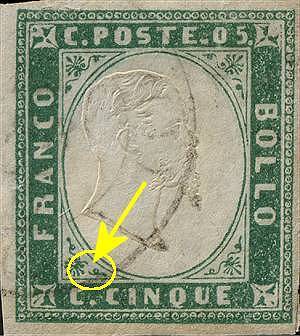
Fig.
1: first plate, first duplication
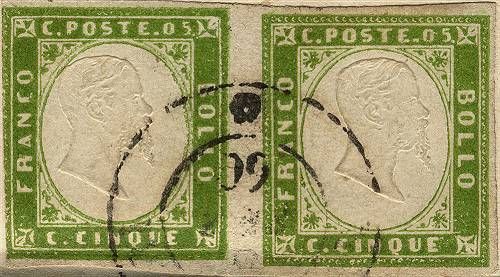
Fig.
2: first plate, second duplication
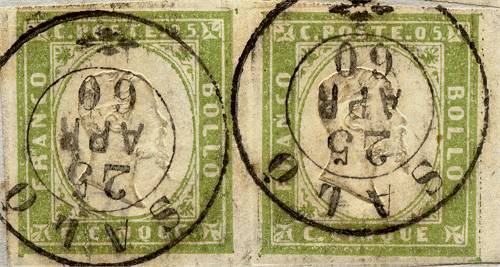
Fig.
3: first plate, third duplication
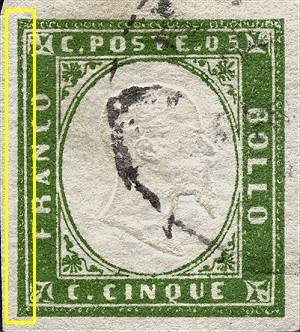
Fig.
4: second plate, fourth duplicastion
10 CENTESIMI
We can summarize as follows the sequence of plates and duplications:
|
1st
DUPLICATION - 1st plate
In the white margins between stamps there are sometimes color traits or dots, specially in the left bottom corner; often the alignment between stereotypes is poor and the stamps sometimes look very tilted; effigy embossed always with the first system (see introduction to the issue) - Fig. 5 - |
|
2nd
DUPLICATION -
2nd plate
No color dots or traits in the white margins; the alignment between stereotypes is much better; effigy embossed with the 1st and 2nd system (see introduction to the issue); it appears from mid July 1859(Fig. 6). |
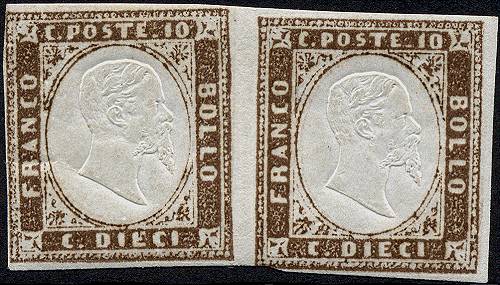
Fig.
5: first plate: note the poor alignment of the stereotypes
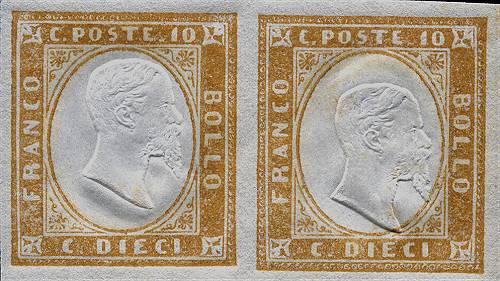
Fig.
6: second plate
20 CENTESIMI
We can summarize as follows the sequence of plates and duplications:
|
1st
DUPLICATION - 1st plate
In the white margins between the various stamps there are sometimes color traits and/or dots, even very large, specially in the last printing runs; the alignment both vertical and horizontal is often very bad and the stamps appear sometimes very tilted; effigy embossed always with 1st system (see introduction to the issue) - Fig. 7 - |
|
2nd
DUPLICATION-
2nd plate
There are no color dots or traits in the white margins; the alignment between stereotypes is much better; in the last printing runs we can see often marks of parasitic printing, specially in the area of the central oval. Effigy embossed with the 1st and the 2nd system (see introduction to the issue); it appears from mid July 1859 (Fig. 8). |
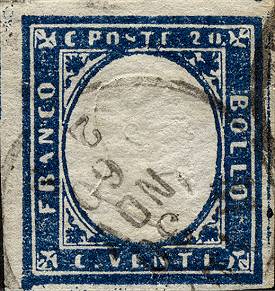 |
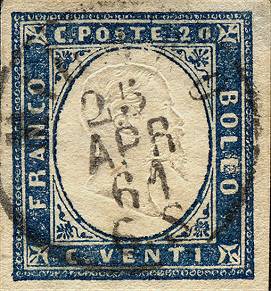 |
|
Fig.
7: first plate. Note the color dots and
the color lines in the white margins |
Fig.
8: second plate
|